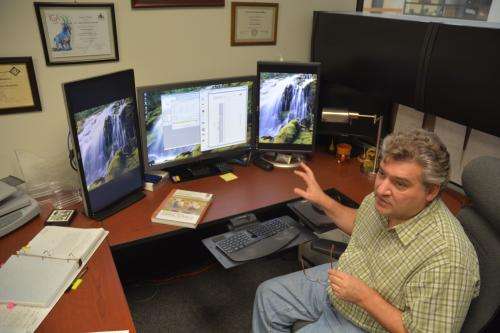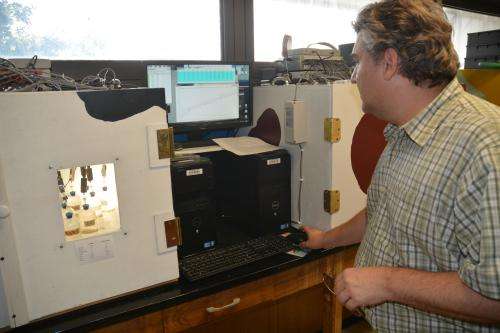Applied nutrition modeling producing beef more profitably, helping reduce methane emissions in feedlots

Nutritional modeling systems developed in the department of animal science at Texas A&M University have helped participating Texas feedlot operators keep feed costs in check and produce beef more profitably. Now, these models have the potential to be applied to help reduce greenhouse emissions, according to researchers.
Dr. Luis Tedeschi, Texas A&M AgriLife Research nutritionist and associate professor in the department of animal science, has extensively studied decision support systems, specifically nutritional modeling. While a doctoral student at Cornell University, Tedeschi worked with Dr. Danny Fox in developing the Cornell Net Carbohydrate and Protein System model for evaluating herd nutrition and nutrient excretion.
At Texas A&M, Tedeschi built upon that work in developing the Cattle Value Discovery System, or CVDS, which helps feedyards sort animals into homogenous groups so that a higher percentage reach a desired level of grade on the day the pen is marketed.
"Usually when feedlots receive animals, they group them in pens by weight," he said. "We changed the paradigm to grouping them according to CVDS-predicted days to reach the target U.S. Department of Agriculture quality grade, usually USDA low choice."
Also, nutritionists have typically formulated cattle rations that often contained excess nutrients to ensure that growth rate was maximized, which often increased nutrient excretion and contributed to adverse effects on water and air quality, Tedeschi said.
The Large Ruminant Nutrition System, LRNS, is a computer model that estimates beef and dairy cattle nutrient requirements and supply under specific conditions of animal type, climatic conditions, management and physiochemical composition of available feeds. This model uses the same computational engine of the Cornell Net Carbohydrate and Protein system, Tedeschi said.
The CVDS modeling system is used by Performance Cattle Company and Micro Beef Technologies among others. When used in combination with the LRNS, the CVDS creates a complete ration for each animal and predicts a day to reach the target USDA grade. An RFID (radio frequency identification)ear tag system monitors which lots of animals receive a certain kind and amount of feed ration.

"It's a very complete model for nutrition," Tedeschi said. "In addition to improving performance and profitability while reducing environmental impact, these models help producers and consultants understand nutrient requirements and feed utilization in beef, sheep and goats."
The modeling system can also be applied in predicting Expected Progeny Difference for breeding herd replacements.
At Texas A&M, in support of the LRNS and CVDS models, Tedeschi has developed in vitro gas production systems to assess digestion characteristics and biological valuesof feeds based on their pattern of accumulated gas during incubation with rumen fluid under anaerobic conditions. This process is a re-engineered version of that developed by Cornell researchers Dr. Alice Pell and Peter Schofield, who designed a computerized closed system using flasks connected to pressure sensors, Tedeschi said.
"The data collected from these samples is imported into a spreadsheet, which automatically calculates fractional degradation rates of fiber and nonfiber-carbohydrates to estimate total digestible nutrients and metabolized energy of feeds," he said. "This information is utilized by nutritionists using the LRNS to formulate and balance rations."
The in vitro technology also helps evaluate how much methane is generated in a formulated feed ration, which can be used to reduce greenhouse gas emissions.
"In a sense, what is really nice is these same ideas started with nutrition models," Tedeschi said. "We are trying to improve how we feed animals and get a better understanding of physiological makeup and into informatics. The most benefit is to Texas and the beef companies."
Tedeschi said contemporary competition for use of resources, environmental and economical challengesin animal agriculture has raised the bar for all major players in the animal industry.
"Decision support systems are more important than ever because they give users the ability to quickly evaluate multiple scenarios of production and choose options that are more acceptable, sustainable and resilient," he said.
Tedeschi said the latest modeling project, the Ruminant Nutrition System, is a more comprehensive decision support system model that integrates cattle, sheep and goats into one platform.
"The main objective of the RNS is to provide a framework for incorporating and implementing new scientific knowledge and sub-models to more accurately predict nutrient requirements and biological values of feedstuffs for ruminants in a perpetually challenging world."
Work on this modeling system continues, he said, and can be used in multiple applications among the livestock feeding sector.
More information: For more information on the models, visit nutritionmodels.tamu.edu/models.html
Provided by Texas A&M University


















